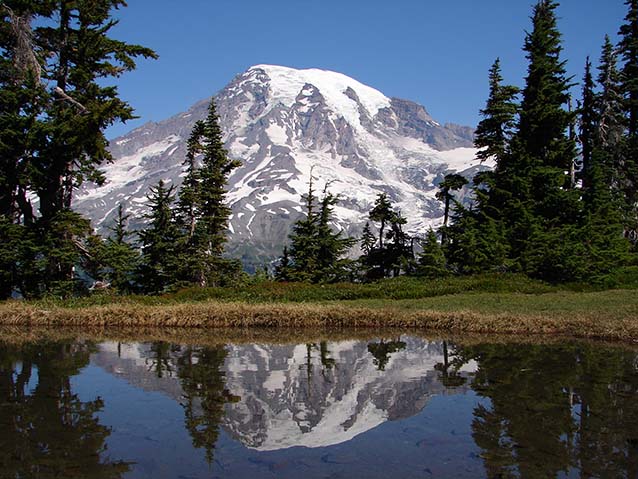
NPS Photo
This region is one of the youngest and most tectonically active in North America. There is ongoing mountain-building in this area which you can see by the rugged and mountainous landscape that extends from Alaska to South America. The Cascade-Sierra Mountains and Pacific Border provinces straddle the boundaries between several of Earth's moving plates. These moving plates are the source of the monumental forces required to build the sweeping arc of mountains. This province has several subprovinces, including the active and sometimes deadly volcanoes of the Cascade Range and the young, steep mountains of the Sierra Nevada.
Sierra Nevada
The rocks that form the backbone of the Sierra Nevada are mostly granitic rocks that formed during the Mesozoic Era, when dinosaurs roamed the Earth. At that time, an arc-shaped chain of volcanoes, similar to the present-day Cascade volcanic arc, erupted where the Sierra Nevada now stands. Molten rock erupted at the surface as lava, but most solidified deep within the earth, forming the gray granitic rocks familiar to any Sierra traveler.
Less than five million years ago, the range that we now know as the Sierra Nevada began to rise along its eastern margin. The Sierra rose upward through a combination of uplift of the Sierran block and down-dropping of the area to the east.
Not long after the Sierra uplift began, the Earth cooled, marking the beginning of the time period known as the Pleistocene (Ice Age) Epoch. Glaciers formed in the Sierra highlands and advanced down former stream channels, carving U-shaped valleys. The sheer walls and hanging valleys of Yosemite National Park are a product of this chilly past.
Cascade Range
Where the Sierra Nevada, ends the Cascade volcanoes begin. This chain of explosive volcanic centers form an arc-shaped band extending from British Columbia to Northern California, roughly parallel to the Pacific coastline. Within this region, 13 major volcanic centers lie in sequence, like a string of explosive pearls.
The Cascades are made up of a band of thousands of small, short-lived volcanoes that have built a platform of lava and volcanic debris. Rising above this volcanic platform are a few strikingly large volcanoes that dominate the landscape. The Cascades volcanoes define the Pacific Northwest section of the Pacific Ring of Fire.

NPS Photo
Educational Resources
A String of Volcanoes
- In this lesson plan students research information about Cascade volcanoes in Washington, Oregon, and California, then transfer the information onto the appropriate mobile piece before constructing the mobile "A String of Volcanoes".
Climate Science in Focus: Earth as a System
- In this unit students will learn about the four Earth systems and how they are connected. Designed around 9th grade Next Generation Science Standards, it is a unit easily adapted down for middle school or up for advanced high school classes.
Climate Change: North Cascades National Park
- In this interactive learning activity students and teachers have the opportunity to play games, download lesson plans, and participate in an electronic field trip with Jeff Corwin.
Cascade-Sierra Parks
- Crater Lake National Park, Oregon—[Geodiversity Atlas] [Park Home ]
- Devils Postpile National Monument, California—[Geodiversity Atlas] [Park Home]
- Lava Beds National Monument, California—[Geodiversity Atlas] [Park Home]
- Lake Chelan National Recreation Area, Washington—[Geodiversity Atlas] [Park Home ]
- Lassen Volcanic National Park, California—[Geodiversity Atlas] [Park Home]
- Manzanar National Historic Site, California—[Geodiversity Atlas] [Park Home]
- Mount Rainier National Park, Washington—[Geodiversity Atlas] [Park Home]
- North Cascades National Park, Washington—[Geodiversity Atlas] [Park Home ]
- Ross Lake National Recreation Area, Washington—[Geodiversity Atlas] [Park Home]
- Sequoia & Kings Canyon National Parks, California—[Geodiversity Atlas] [Park Home]
- Yosemite National Park, California—[Geodiversity Atlas] [Park Home]
Part of a series of articles titled Physiographic Provinces.
Previous: Blue Ridge Province
Next: Central Lowland Province
Last updated: April 30, 2018
